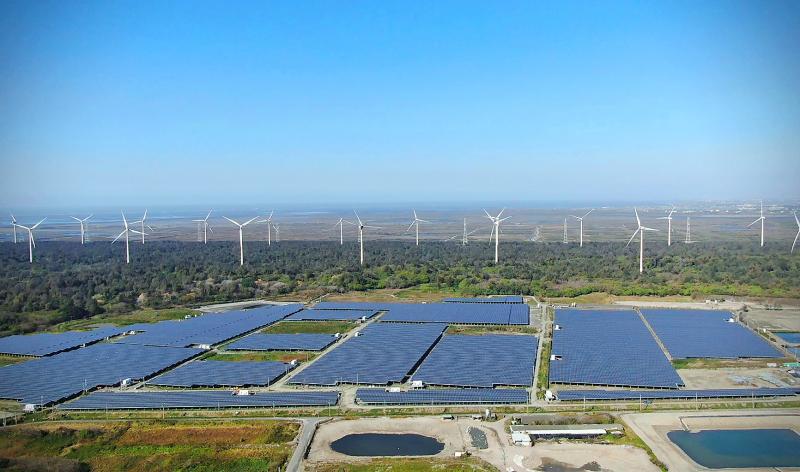Cathay Life Insurance Co (國泰人壽) aims to double its cumulative investment in domestic solar power projects to at least NT$20 billion (US$716.8 million) by 2025, as the green energy business yields high rates of return and growing the sector is good for the environment, Cathay Life president Liu Shan-chi (劉上旗) said on Saturday.
The life insurer has invested NT$10 billion in 250 local photovoltaic farms, including rooftop, ground-mounted and floating solar systems, with a combined capacity of 200 megawatts (MW).
The company plans to seek more projects in coming years, boosting the overall capacity of the photovoltaic farms it invests in to 400MW or more by the end of 2025, Liu said.

Photo courtesy of Cathay Financial Holding Co via CNA
Given that the average construction cost for solar power projects stands at NT$50 million per megawatt of capacity, Cathay Life’s cumulative solar investment is expected to total at least NT$20 billion by 2025, he said.
On Saturday, the life insurer launched a NT$5 billion ground-mounted solar power station in Yunlin County’s Mailiao Township (麥寮).
Cathay Life is partnering with Solar Master Energy Co Ltd (開陽能源) and San Ching Engineering Co (三井工程) to invest in the station, which has a targeted capacity of 100MW.
The three firms formed a joint venture, CM Energy Co Ltd (開泰能源), with paid-in capital of NT$1 billion. Cathay Life holds a 45 percent stake, and Solar Master and San Ching hold 30 percent and 25 percent stakes respectively, Liu said.
The life insurer said that the station has a capacity of 26MW and has been connected to Taiwan Power Co’s (台電) grid since March.
The station plans to build up the remaining capacity from next year, it added.
As the station is situated in an area affected by land subsidence — gradual sinking or settling — it took the companies five years to finish preliminary work, such as negotiating with land owners and completing land leveling and piling. Solar Master said that 9m piles and anti-corrosion coating have been used in the project due to its special topography.
Although building photovoltaic systems in areas affected by land subsidence costs about NT$60,000 per kilowatt, higher than for regular projects, the station is expected to yield an internal rate of return of between 4.5 and 5 percent, higher than a return of less than 3 percent for the life insurer’s investment in real estate, it said.
Asked whether solar power could be sold to companies in the private sector, Solar Master chairman Tsai Tsung-jung (蔡宗融) said chances would be slim, as the partners signed a contract with Taipower in 2018 to sell power for about NT$5 per unit.
As the government has cut the feed-in tariff rates for solar energy since 2018, power is more likely to be purchased from other photovoltaic projects at cheaper rates, Tsai said.
Cathay Life has established Cathay Power Inc (國泰電業) to focus on green energy investment, making it the nation’s first life insurer to create a utility-related subsidiary.

SEEKING CLARITY: Washington should not adopt measures that create uncertainties for ‘existing semiconductor investments,’ TSMC said referring to its US$165 billion in the US Taiwan Semiconductor Manufacturing Co (TSMC, 台積電) told the US that any future tariffs on Taiwanese semiconductors could reduce demand for chips and derail its pledge to increase its investment in Arizona. “New import restrictions could jeopardize current US leadership in the competitive technology industry and create uncertainties for many committed semiconductor capital projects in the US, including TSMC Arizona’s significant investment plan in Phoenix,” the chipmaker wrote in a letter to the US Department of Commerce. TSMC issued the warning in response to a solicitation for comments by the department on a possible tariff on semiconductor imports by US President Donald Trump’s

The government has launched a three-pronged strategy to attract local and international talent, aiming to position Taiwan as a new global hub following Nvidia Corp’s announcement that it has chosen Taipei as the site of its Taiwan headquarters. Nvidia cofounder and CEO Jensen Huang (黃仁勳) on Monday last week announced during his keynote speech at the Computex trade show in Taipei that the Nvidia Constellation, the company’s planned Taiwan headquarters, would be located in the Beitou-Shilin Technology Park (北投士林科技園區) in Taipei. Huang’s decision to establish a base in Taiwan is “primarily due to Taiwan’s talent pool and its strength in the semiconductor

Industrial production expanded 22.31 percent annually last month to 107.51, as increases in demand for high-performance computing (HPC) and artificial intelligence (AI) applications drove demand for locally-made chips and components. The manufacturing production index climbed 23.68 percent year-on-year to 108.37, marking the 14th consecutive month of increase, the Ministry of Economic Affairs said. In the first four months of this year, industrial and manufacturing production indices expanded 14.31 percent and 15.22 percent year-on-year, ministry data showed. The growth momentum is to extend into this month, with the manufacturing production index expected to rise between 11 percent and 15.1 percent annually, Department of Statistics

An earnings report from semiconductor giant and artificial intelligence (AI) bellwether Nvidia Corp takes center stage for Wall Street this week, as stocks hit a speed bump of worries over US federal deficits driving up Treasury yields. US equities pulled back last week after a torrid rally, as investors turned their attention to tax and spending legislation poised to swell the US government’s US$36 trillion in debt. Long-dated US Treasury yields rose amid the fiscal worries, with the 30-year yield topping 5 percent and hitting its highest level since late 2023. Stocks were dealt another blow on Friday when US President Donald